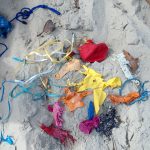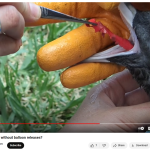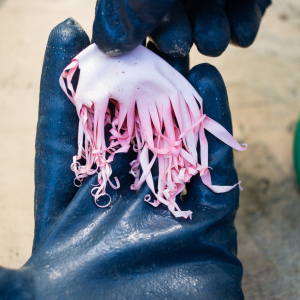No Balloon Release SRP
Source Reduction Plan (SRP) Overview
Name of SRP
Partners Delivering the SRP
- Tangaroa Blue Foundation – Keegan Vickers & Mathilde Gordon
- No Balloon Release Australia – Karen Joynes
- Owens Wildlife Adventures – Owen Harris
- Cairns Turtle Rehabilitation Centre – Jennie Gilbert
- Videographer: Gus Burrows, Styledia
Location
- Great Barrier Reef QLD
- Online (national)
Photo 1
Evidence of the issue

Photo 2
Evidence of SRP resources

Photo 3
Evidence of positive outcomes
Overall Goals & Background
Targeted Debris
- Balloons – latex & mylar/helium
- Ribbon – non-woven poly satin, nylon or polyester material
Why is the SRP needed?
Once released, helium balloons can drift for hundreds of kilometres before descending or bursting to produce many fragments that also descend. Often, these end up in the ocean. Marine animals can mistake them for food and swallow them or become entangled in the attached ribbon. Such encounters can lead to loss of limbs, drowning or starvation for turtles, seabirds, whales, dolphins, and dugongs. In Queensland, the release of balloons into the environment is considered littering under the Waste Reduction and Recycling Act 2011—whether released deliberately or by accident.
Despite Queensland being an early adopter of legislation that deems balloons to be litter, we still regularly find balloon debris on clean-ups across Queensland and the Great Barrier Reef.
At the time, the QLD educational content on balloons, balloon releases and their impact on the environment and wildlife was long (greater than 5 minutes), contained conflicting information, was not specifically relevant to the state of Queensland/Great Barrier Reef catchment area and is not backed up by statistics.
Tangaroa Blue has been vocal in the balloon release debate for many years and is a strong partner with No Balloon Release Australia.
We wanted to create a more fit-for-purpose informational campaign that is accurate and solutions-focused, limiting distressing content and highlighting alternatives. We are also able to provide credible data for the campaign with statistics from the AMDI Database.
Logistics
Timeline and Project Goals
July 2022 – August 2023
- Confirm budget for video
- Contact videographers – obtain initial availability, quotes
- Begin crafting creative vision for video (draft storyboard ideas)
- Decide on celebrations to highlight and appropriate alternatives
September – November 2022
- Confirm videographer
- Confirm video type/style (animated, etc.)
- Continue crafting storyboards
December 2022
- Confirm storyboards
- Pre-production budget & materials
- Pre-production shot list finalised
January 2023
- Video interviewees finalised
- Obtain stock footage
March 2023
- Interview scripts finalised
- Filming & editing occurs
April 2023
- Filming & editing occurs
May 2023
- Filming & editing occurs
- Production complete
- Website landing page created
June 2023
- Video shared on social media, through partners
Goals
- Create a clear and concise informative video to discourage balloon use and balloon releases in the GBR catchment area.
- Build awareness that releasing balloons is considered littering or illegal dumping (QLD Waste Reduction and Recycling Act of 2011)
- Urge individuals to mark significant occasions (birthdays, gender reveals, celebrations, promotions, memorials, etc) with eco-friendly alternatives to balloons, such as paper decorations, potted plants, or digital greetings.
- Promote the importance of individual actions – individuals CAN make a significant difference in this problem
- Recommend greater helium regulation under the National Plastics Plan (regulating the sale of helium for inflating balloons would help prevent them from being released in the first place)
Overall, the aim is to see a reduction in the amount of balloon releases made by the public and, therefore, see a reduction in balloon marine debris in the AMDI database.
Measuring Success
One asset was created and delivered: a Short video (1-2 mins) appropriate for sharing on social media.
The target audience consists of current Tangaroa Blue Foundation followers and the general public. We aimed to promote balloon debris-consciousness and change the public’s perception of balloon releases.
We measure community engagement through;
- Social media: share videos on social media channels & track engagement (views, likes, shares, etc)
- Website Landing page for project with project background, petition, balloon alternatives (track views/traffic)
- Community engagement/outreach – Community engagement mainly through social media posts and production
- National Plastics Plan – greater regulation of helium use for inflating balloons
Data Collection & Reporting
Data was quantified through video outreach, social media metrics, and overall engagement across social platforms, as well as AMDI Database data comparisons.
Results and Reflections
Positive Outcomes
We have achieved a significant milestone in creating an impactful and hopeful informational campaign. It is accurate, solutions-focused, and has a limited amount of distressing content, while effectively highlighting alternatives.
Views/Downloads;
No Balloon Release short film: 124
No Balloon Release Action Guide 2019: 684
No Balloon Release Fact Sheet 2023: 337
No Balloon Release Action Guide 2023: 20
Social Media;
July 2023 Facebook Post (with resources) – 11 Likes, 2 shares, 324 reach
July 2023 Instagram Post (with video) – 22 Likes, 114 reach
Funding
Costs for assets: $5000
Challenges & Improvements
Some challenges during the production of the video included:
- Budget constraints: A longer film required more time and a higher budget than we had available. Animations were also quite expensive, so we selected a different video format. We opted for a shorter, high-impact video focused on offering alternative solutions to using or releasing balloons.
- Maximizing budget: Kept video to 2 mins in length, limited time on the ground filming, limited videographer travel, used stock footage, had guests film themselves for interviews and send footage directly to videographer
- Videographer Availability: Several videographers had already committed to other projects. Also, many were busier than usual with events and travel as COVID restrictions had eased. With the videography we used, we had to be more flexible with our schedule to accommodate the other projects he was working on and his travel schedule. Ensuring we responded promptly and gave feedback straight away assisted in moving things along.
- Staff expertise: Worked closely with the videographer to create a product that matched our vision and met project outcomes while being realistic given the time and budget constraints.
Some improvements that could be made include:
- Better analysis of how to engage people via social media. This resource could have been shared on social media as a series of Instagram posts
- Only one short film was produced, and we would have liked to have created more 1-2 min videos and linked them together to create a longer film.
Future Opportunities
The video is still available to view and share on YouTube.
A positive outcome is it strengthened our relationship with partners: No Balloon Release Australia, Owen’s Wildlife Adventures, and Cairns Turtle Rehabilitation Centre.
Future opportunities could involve;
- Renewing the information into more digestible formats to engage a wider audience and re-sharing footage on social media at an appropriate time.
- Considering a fresh campaign against balloon releases.
- Consider a campaign against paper lanterns, which might be seen as more environmentally friendly but still have an environmental cost (as environmental litter, a hazard for wildlife, and a potential fire risk).






